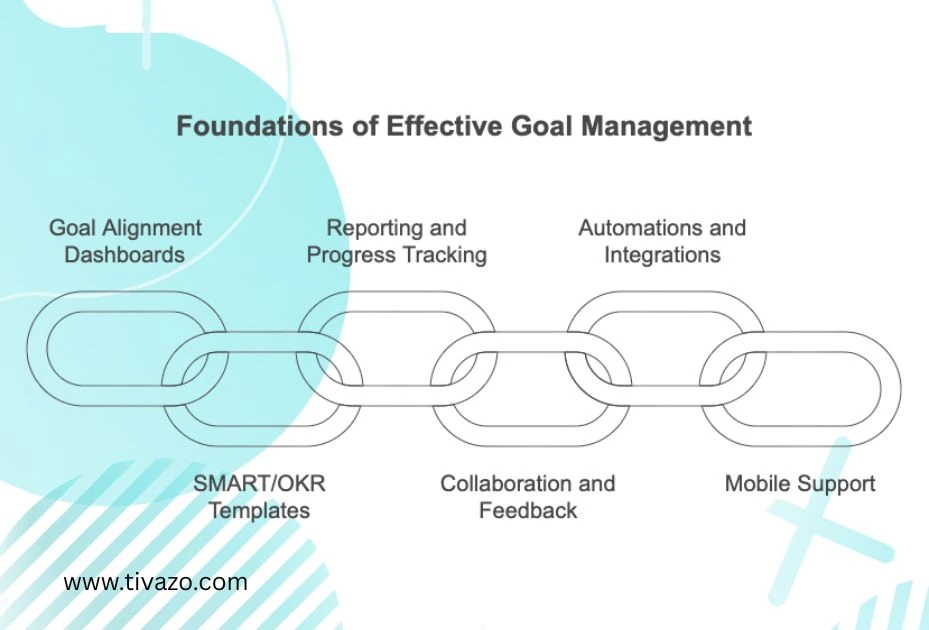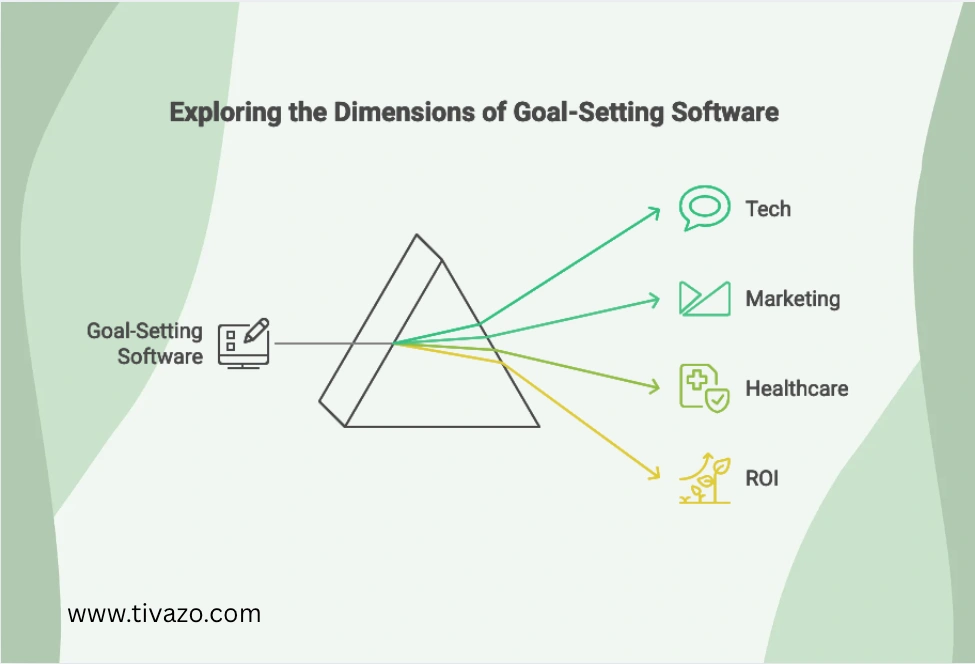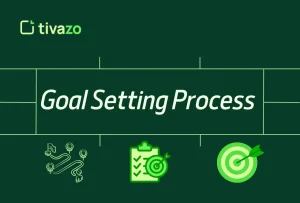The employee goal-setting software is online software that is used to facilitate the process of defining, tracking, and evaluating the goals of employees in an organization. In contrast to the manual approaches that are used in the traditional ways (spreadsheets, hand-written notes, and verbal check-ins), this software can be used to centralize the whole process of goal-setting into an automatic, real-time model.
In essence, employee goal-setting software facilitates cooperation between managers and employees when it comes to the creation of measurable goals against the backdrop of higher organizational goals. Their use usually introduces such frameworks as SMART goals (Specific, Measurable, Achievable, Relevant, Time-bound), OKRs (Objectives and Key Results), and KPIs (Key Performance Indicators), which make goals well-organized and practical.
The manual method normally entails exchanging emails back and forth, failure to meet deadlines, and failure to gain insight into employee performance. Comparatively, employee goal-setting software has a dynamic update availability, timely reminders, and in-time analytics, making the place of work more transparent and accountable.
Besides, this software usually includes dashboards visualizing goals, access, and role-based access, as well as integration with HR systems or task management tools. As an example, the software can be used when a marketing team chooses quarterly OKRs and metrics are driven by integrated tools, such as Google Analytics or Trello.
All in all, employee goal-setting software has the capacity not only to augment productivity but also to become an effective strategy toward alignment, accountability, and ongoing improvement within the workforce.
Why Businesses Will Require Goal-Setting Software among Employees in 2025
By 2025, work in the workplace will have changed greatly as now remote work, hybrid workforce, and remote collaboration have become the norm. With such transformations, organizations are feeling the need to be transparent and accountable in their performance, even in distributed teams. Here, the software on employee goal setting comes in handy.
Real-time goal tracking and feedback loops are more essential than traditional performance reviews. The employee goal-setting software offers an infrastructure in which team leads and the workforce collaborate to create the goals, monitor progress, and revise plans without time wastage. Agility to this extent is crucial when the workplace is fast-paced and digitalized.
Moreover, the software for setting goals has a built-in interface with such tools as Asana, Slack, Trello, and Plaky, to make goal data accessible on the already popular tools the employees currently use. This kind of integration trims down friction and raises adoption, thus performance management becomes a continuous process that is integrated instead of a quarterly task.
Living in a time when staffing and retention are based on clarity, freedom, and acknowledgement, the software helps people observe the impact of their work on organizational performance and success. It promotes the spirit of openness and ongoing feedback, which are the fundamentals of contemporary performance management.
In order to stay competitive by 2025, organizations need to abandon the practice of setting fixed goals in a top-down way and rely on dynamic, technology-advanced methods. The use of employee goal-setting software is no longer an option; it is a must-have.
The Main Functionalities to Consider
When adopting employee goal-setting software, one may consider the necessary functions that will allow organizations to maximize the benefits of using this type of software. Contemporary software solutions provide plenty of tools that are intended to ease the management of goals and enhance cross-team alignment.
Features to consider
Choosing a goal-setting software by an organization requires knowledge of the core features that characterize it to make the most of what it offers. There are many tools provided in the modern software platform to make goal management less challenging and enhance its alignment across departments.

- Goal Alignment-Dashboards: A visual dashboard showing a match between individual and team objectives on the one hand, and the overall company objectives on the other, is also one of the most significant functions. The employee goal-setting software usually comes as a user-friendly dashboard that the manager and employees can view goal progress by just a glimpse of an eye, maintaining a healthy transparency and teamwork spirit.
- SMART/OKR Templates: Many platforms have goal models, such as SMART (Specific, Measurable, Achievable, Relevant, Time-bound) and OKRs (Objectives and Key Results). This assists workers in establishing organized and operational objectives that bring quantifiable results. The software used in goal-setting by employees simplifies the formulation of goals through templates that allow standardization within an organization.
- Reporting and tracking of progress: The ability to monitor in real-time is one of the real benefits of employee goal-setting software. Progress reports and automatic updates save the need for manual data entry and also give timely frequency information with regards to the goals. Bottlenecks or areas requiring assistance can be nipped in the bud since managers who are aware of their occurrence can identify them easily.
- Collaborating and feedback instruments: The way to manage goals well is to maintain constant communication. Most software in employee goal-setting has an in-built feedback system where employees and supervisors can comment, update, and provide recognition within the same platform. This fosters the culture of continual improvement.
- Automations and Automations: Employee goal-setting software can work with the most-used productivity services, such as Slack, Asana, and Plaky, to become more usable. Automated notifications and data syncing save the management loads and allow teams to concentrate on implementation instead of monitoring.
- Mobile Support: Mobile accessibility is critical with the remote and hybrid working styles being the new norm. The most effective employee goal-setting programs have mobile applications or web-based positions (responsive). This enables the user to update and have a look at objectives at any time and from any place
The Best Advantages of Utilizing Employee Goal Setting Software
- The integration of the employee goal-setting software provides an array of benefits that improve the performance of businesses as well as staff members.
- Enhanced Clarity and transparency: Employee goal-setting software does not cause ambiguity because of its definite objectives that are available to all stakeholders. There is no misunderstanding, and each employee can know what is expected, making the rationale to promote responsibility and strategy fit.
- Greater Motivation and ownership: Employees feel motivated and responsible for their job when they can monitor their progress and get constant feedback with the help of software. This enables them to be more productive and be satisfied with their jobs.
- Immediate-time Progressive Knowledge: Managers have real-time dashboards showing the status of goals and the performance of employees in real-time. This will make it easy to make interventions and decisions based on data, thus eliminating surprises when a performance review takes place.
- Reduced Micromanagement: With automatic tracking and visibility of progress, the manager will no longer have to micromanage employees but will be able to coach and guide. The software for employee goal-setting would empower them to be self-guided and at the same time retain control.
- Improved HR decision-making: All the information gathered on the employee goal-setting software assists the HR teams in identifying high performers, gaps in skills, and training requirements. This will help to come up with more informed promotions, remuneration, as well as workforce planning.
- Overall, the goal-setting software for employees creates an environment of continuous improvement in performance since goal-setting and monitoring are a seamless, incorporated experience in the everyday working environment.
Real World-Application
Several organizations in various industries have acted well to ensure that they implement employee goal-setting software to enhance performance and participation.
- Startups: High-growth startups can maintain highly dynamic teams on a path by setting the goals of their employees using employee goal-setting software. As an example, one SaaS startup uses software to align product development, marketing, and sales activities using OKRs, becoming capable of achieving 30 percent more quarterly targets.
- Remote Teams: In distributed teams, being able to keep track of goals is difficult. Employee goal-setting software helps remote-first companies to maintain a sense of connectedness and accountability, since it provides real-time updates and integrates with communication tools such as Slack.
- Large Enterprises: Employee goal-setting software helps multinational companies because goals can be set in a uniform process in all departments and locations. Performance review cycles of a healthcare company were cut by 40 percent through goal management systems and HR software.
Industry-Specific Examples:

- Tech: Monitoring the process of innovation and product milestones
- Marketing monitoring of campaigns, KPI, and lead generation goals
- Healthcare: establishing compliance and patient care goals
- ROI: Research shows that up to a 20 percent improvement in employee productivity and engagement is registered by organizations that utilize employee goal-setting software. This can be converted into increased income growth and low employee staff attrition.
Selecting the most appropriate Employee Goal Setting Software
The most effective employee goal-setting software should be chosen with appropriate consideration of the needs of the organization and the possibilities of the software.
Selection Criteria:
- Price: Subscription and total cost of ownership.
- User Experience (UX): Efficient and easy-to-use interfaces prompt usage.
- Scalability: Make sure the software is developed with the organization.
- Customer Support: Trusty support reduces the downtime.
- Integrations: It must be compatible with the existing tools such as Plaky, Slack, and HRIS systems.
Questions to be Asked of Vendors:
- Does the software allow SMART objectives and OKRs?
- What is the capability of reporting and analytics?
- How flexible are the dashboard and notifications?
Best Practices of Implementations
The implementation of employee goal-setting software is a process that needs to be planned out and executed. The following are the best practices in order to implement easily and succeed in the long term.

- Getting Buy-In of Secure Leadership: The most important support is the support of the leadership. Adoption of employee goal-setting software would require leaders to reinforce the use of the software by explaining its advantages and motivating everyone to take part in those activities.
- Educate Managers and workers: Training covers all aspects, which makes users know how to structure effective goals and goals and explanations on how to attain them by using the platform resources, as well as decipher the progress reports. Training increases the adoption and confidence.
- Put Reasonable Deadlines: Do not be in a hurry to make the rollout. One should always start with a phased rollout or pilot teams to obtain feedback and iron out the processes before a broader organization-wide rollout.
- Begin at Pilot Teams: The pilot teams will enable you to pilot the employee goal-setting software through a controlled environment with the features to recognize difficulty and also demonstrate early victories to encourage the greater implementation.
- Check Rates of Adoption: Measure track usage and obtain user feedback regularly. Dispel any opposition or technical difficulties immediately to sustain momentum.
Stay on the Evolution Conditioned by Feedback: It is all about continuous improvement. Employ the information obtained through the employees ‘ goal-setting software analytics and input to streamline goal-setting and software customization.
These steps can help organizations achieve the greatest ROI of employee goal-setting software and instill a performance excellence culture.
Summary
Employee goal-setting software can be used to make this happen and become a strong driver of individual effort and company strategy. Along with the development of workplaces, setting, monitoring, and adjusting goals live are not something that can be done without.
With the adoption of employee goal-setting software, companies will be able to create some transparency, accountability, and constant feedback, which are the key components of contemporary performance management. This software provides flexible solutions suitable for any business, whether a start-up hoping to experience fast expansion or a business that wants some form of standardization.
Want to have a workforce that can work with definite, measurable objectives?




